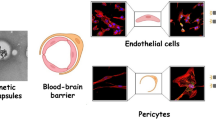Summary
Erythrocytes have been proposed as biogradable cellular carriers for drugs. Potentials of this therapeutic approach are organ-specific targeting, protection and prolonged in vivo function of the encapsulated drugs. Previous studies demonstrated the advantage of a hypo-osmotic dialysis procedure for macromolecule loading resulting in cells that are closely similar to normal erythrocytes. Osmotic fragility of unloaded and loaded “carrier” erythrocytes was studied both in respect of shelf-life and in vivo survival. Sudden haemolysis which is characteristic for normal erythrocytes was never obtained with carrier erythrocytes. Haemolysis appeared at all osmotic pressures and increased stepwise indicating the existence of various cell populations. However, the majority of cells were haemolysed at lower values of the osmotic fragility curve. Osmotic fragility was highly increased when cytotoxic chemotherapeutics were encapsulated, and these cells appeared as spherocytes using scanning electron microscopy. Osmotic fragility proved to be a simple but reliable method for the in vitro evaluation of carrier erythrocytes and the effect of the encapsulated substances.
Similar content being viewed by others
References
Castle WB, Daland GA (1937) Susceptibility of mammalian erythrocytes to haemolysis with hypotonic solution. Arch Int Med 60:949–966
Chang TMS (1978) Biomedical applications of immobilized enzymes and proteins. Academic Press, London
Dacie JV, Lewis SM (1968) Practical haematology, 4th edn. Churchill, London
Dale JV, Villacorte DG, Beutler E (1977) High-yield entrapment of proteins into erythrocytes. Biochem Med 18:220–225
DeLoach JR, Ihler GM (1977) A dialysis procedure of loading erythrocytes with enzymes and lipids. Biochem Biophys Acta 496:136–145
DeLoach JR, Barton C (1982) Circulating carrier erythrocytes: slow-release vehicle for antileukemic drug cytosine arabinoside. Am J Vet Res 43:2210–2212
DeLoach JR, Barton C (1981) Glutaraldehyde-treated carrier erythrocytes for organ targeting of methotrexate in dogs. Am J Vet Res 42:1971–1974
DeLoach JR, Wagner AA, Craig TM (1981) Almidocarb dipropionate encapsulation and binding to resealed carrier bovine erythrocytes for potential babesiosis chemotherapy. J Appl Biochem 3:254–262
Gregoriadis G (1979) Drug carriers in biology and medicine. Academic Press, London
Ham TH, Castle WB (1940) Studies on destruction of red blood cells. Proc Am Philos Soc 82:411–419
Hoffmann JF (1958) The physiological characteristics of human red blood cell ghosts. J Gen Physiol 42:9–16
Hubbard AR, Sprandel U, Chalmers RA (1980) Organic acid transport in resealed haemoglobin containing human erythrocyte “ghosts.” Biochem J 190:653–658
Ihler GM, Glew RH, Schnure FW (1973) Enzyme loading of erythrocytes. Proc Natl Acad Sci USA 70:2663–2666
Sprandel U, Hubbard AR, Chalmers RA (1979) In vitro studies on resealed erythrocyte ghosts as protein carriers. Res Exp Med (Berl) 175:239–245
Sprandel U, Hubbard AR, Chalmers RA (1981) Towards enzyme therapy using carrier erythrocytes. J Inherited Metab Dis 4:99–100
Sprandel U, Hubbard AR, Chalmers RA (1979) Membrane transport in resealed haemoglobin-containing human erythrocyte “ghosts” prepared by a dialysis procedure. Biochem Biophys Res Commun 91:79–85
Sprandel U, Chalmers RA (1980) Morphologie von Erythrozytenschatten als in vivo-Trägersysteme. Verh Dtsch Ges Inn Med 86:1090–1092
Sprandel U, Hubbard AR, Chalmers RA (1980) Survival of “carrier” erythrocytes in dogs. Clin Sci 59:7–8
Sprandel U, Hubbard AR, Chalmers RA (1981) In vivo-Überlebenszeit von Erythrozytenschatten als Trägersysteme für Pharmaka. Verh Dtsch Ges Inn Med 87:1172–1174
Weed AI, Reed CF (1966) Membrane alterations leading to red cell destruction. Am J Med 41:681–698
Williams TF, Fordham CC, Hollander W, Welt LG (1959) Study of the osmotic behavior of the human erythrocyte. J Clin Invest 38:1587–1596
Author information
Authors and Affiliations
Rights and permissions
About this article
Cite this article
Sprandel, U., Zöllner, N. Osmotic fragility of drug carrier erythrocytes. Res. Exp. Med. 185, 77–85 (1985). https://doi.org/10.1007/BF01851531
Received:
Accepted:
Issue Date:
DOI: https://doi.org/10.1007/BF01851531




